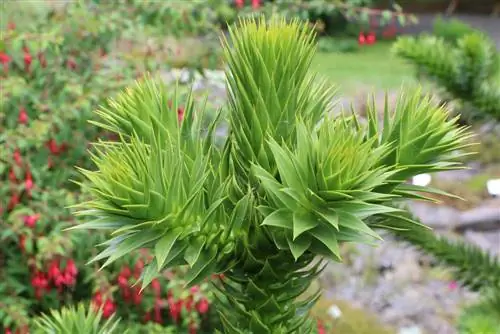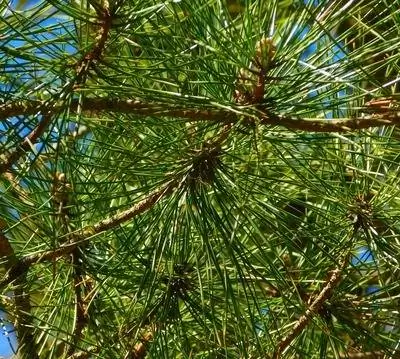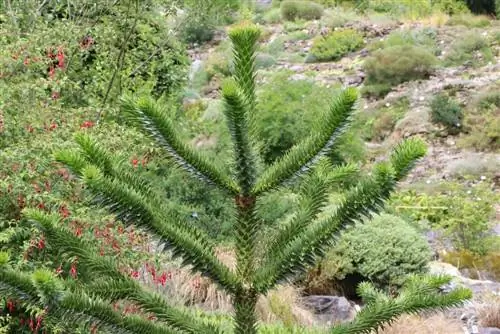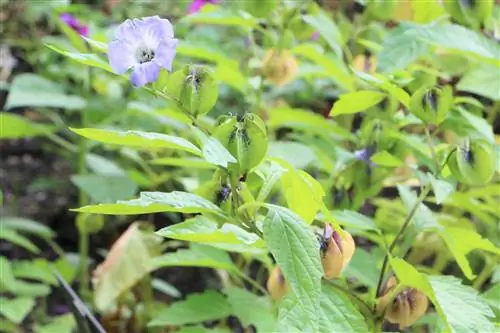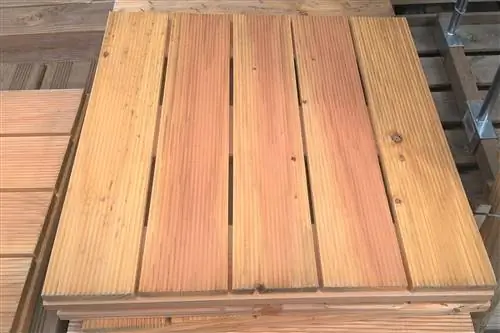- Author admin [email protected].
- Public 2023-12-17 03:39.
- Last modified 2025-01-24 12:45.
The Chilean Araucaria is an evergreen tree that can grow to between 30 and 50 meters high in its homeland and has a trunk diameter of up to 2 meters. An araucaria needs a lot of time because it grows very slowly, which doesn't do any harm as the impressive tree can live up to 2,000 years.
Wonderful Araucaria
The araucaria has been able to show its leisurely growth in this world for a very long time. Fossil finds of Araucaria relatives have been estimated to be up to 90 million years old - making the Araucariaceae family one of the oldest tree families in the world. The Chilean Aracaria forms a bark that is up to 14 centimeters thick, which allows it to grow undisturbed even after a volcanic eruption - this bark makes up up to 25% of the trunk volume.
Location and care of a Chilean Araucaria
The Chilean Araucaria has its home in the Chilean Andes, where a region is named after it. In this region, the evergreen araucaria grows at altitudes between 600 and 1,700 meters. The temperatures there are between a maximum of -15 and +30 degrees.
The Chilean Araucaria was introduced to Europe around 200 years ago, where it thrives in a similarly mild climate to its homeland. In north-western Europe it is only hardy in the milder areas; in the British Isles, for example, it enriches. B. Many park landscapes with their exotic appearance. In the warmest locations in Germany, e.g. B. in the Botanical Garden in Karlsruhe, she feels comfortable outdoors.
If you live in such a mild area, you can plant your Chilean Araucaria in the garden. Then it needs well-drained but nutrient-rich soil; good experiences have been made with a mixture of humus, loamy soil and sand. The location should offer the highest possible humidity and be sunny to partially shaded.
- It is important that you prevent your araucaria from drying out. If it is to be planted in very heavy soil, you should therefore first add a drainage layer of gravel at least 20 cm thick to the planting hole before planting the araucaria.
- If the Chilean Araucaria is exposed to the sun all day at certain times of the year, a fleece or net on the crown protects it from drying out. If you think this is an exaggeration, you should be aware that brown needles on an araucaria are almost always caused by drought and very rarely by frost damage.
- If you don't live in such a warm area, you should keep the Chilean araucaria in a pot. Here too it needs a substrate with the qualities described above, here too you must ensure constant moisture in the soil and in the air.
- Araucaria is naturally more at risk of frost in the pot, so it is better to overwinter indoors frost-free, in a bright room at around 5 degrees.
In the summer season, the araucaria needs plenty of water; it should receive some conifer fertilizer about once a month or be supplied with nutrients via a slow-release fertilizer. During wintering, the araucaria is watered less; it should receive just enough water to prevent the root ball from drying out.
Buy Chilean Araucaria
Because it grows so slowly, buying a Chilean Araucaria of some size is not an inexpensive pleasure. An araucaria that is 90 to 100 cm high costs around 300 euros and is delivered in a 30 liter planter. She will e.g. B. offered by the company flora toskana from 89278 Nersingen.
If you would like to grow your own araucaria from seeds, you can get it for example. B. at fesaja-versand from 37318 Schönhagen, www.fesaja-versand.de, a pack of 5 seeds costs just under 5 euros.
Growing your own from seeds
The seeds are placed with the tip down (with the lighter part) halfway into the growing soil. Cocohum or a mixture of commercially available growing soil and a third of sand or perlite or vermiculite are suitable. The planter, which has a well-functioning water drain, is then moistened, covered and then moved into the cold for three to four weeks. It should be around 5 degrees, whether in the refrigerator or in the tool shed.
Araucaria needs the cold stimulus, which is biologically known as stratification, in order to be stimulated to germinate. After the seeds have matured on the mother plant, they go into dormancy, which is intended to prevent the seeds from germinating on the mother plant. Many types of seeds then need a cold period before they overcome dormancy, otherwise they would germinate before the onset of winter, i.e. at a very unfavorable time. The stratification artificially replicates winter.
When the cold period is over, the planters are placed in a sunny to partially shaded environment with a temperature between 15 and 20 degrees (optimal should be 18 degrees). They must now be kept consistently moist, but the soil must never become dripping wet. Seedlings should appear after 3 to 4 weeks; they will be separated as soon as they are easy to grasp. After transplanting into the final pot, all you really have to do is make sure that the araucaria receives enough water.
If you cultivate an araucaria, you are also doing something for the preservation of biodiversity: The Chilean araucaria is threatened with extinction due to uncontrolled logging; it is an international species protection.

